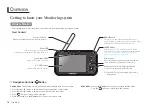
61
EN
Annex
Guidance and manufacturer´s declaration – electromagnetic emissions
The device is intended for use in the electromagnetic environments listed below, and should
only beused in such environments:
Emission test
Compatibility
Notes concerning the EM environment
RF emissions CISPR 11
Group 1
RF energy is used only to maintain device’s
operation. Therefore, its RF emissions are so
low that it’s not likely to cause any interference
in nearby electronic equipment.
RF emissions CISPR 11
Class B
The device is suitable for use in all establish-
ments, including domesticestablishments,
and those directly connected to the public
low-voltage power supply networkthat supplies
buildings used for domestic purposes.
Harmonic emissions
IEC 61000-3-2
Class A
Voltage
fl
uctuations /
fl
icker
emissions IEC 61000-3-3
complies
Guidance and manufacturer´s declaration – electromagnetic emissions
The device is intended for use in the electromagnetic environments listed below, and should
only beused in such environments:
Immunity test
IEC 60601 –
test level
Compliance
level
Electromagnetic environment -
guidance
Electrostatic
discharge (ESD)
IEC 61000-4-2
± 6 kV contact
± 8 kV air
± 6 kV contact
± 8 kV air
Floors should be wood, concrete or
ceramic tile. If
fl
oors are covered with
synthetic material, the relative humidity
should be at least 30 %.
Power frequency
(50/60 Hz)
magnetic
fi
eld
IEC 61000-4-8
3 A/m
3 A/m
The power frequency magnetic
fi
eld
should be measured at the intended
place of installation in order to ensure
that it is low enough.
Recommended separation distances between portable and mobile RF communication
The device is intended for use in an electromagnetic environment where radiated RF
disturbancesare under control. User can help prevent electromagnetic interference by keeping
the device at a minimum distance from portable and mobile RF communications equipment
(transmitters). Below table details the maximum output power of transmitter:
Rated maximum
output power
of transmitters
in Watt
Seperation distance according to frequency of transmitter / m
150 kHz to 80 MHz
d = 1.2
√
P
80 MHz to 800 MHz
d = 1.2
√
P
800 MHz to 2.5 GHz
d = 2.3
√
P
0.01
0.1
1
10
100
0.12
0.38
1.2
3.8
12
0.12
0.38
1.2
3.8
12
0.23
0.73
2.3
7.3
23
For transmitters rated at a maximum output power not listed above, the recommended separa-
tion distance d in metres (m) can be estimated using the equation applicable to the frequency
of the transmitter, where P is the maximum output power rating of the transmitter in watts (W)
according to the transmitter manufacturer.
NOTE 1:
At 80 MHz and 800 MHz the higher frequency range should be used.
NOTE 2:
These guidelines may not be applicable in all situations. Electromagnetic
propagation is in
fl
uenced by absorption and re
fl
ection from buildings, ob-
jects and people.



































